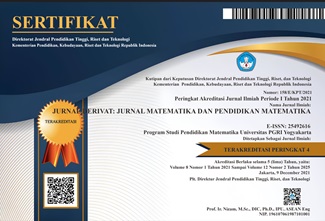Pengembangan Model Pembelajaran ARCS (Attention, Relevance, Confidence, Satisfaction) Dengan Wolfram Mathematica
DOI:
https://doi.org/10.31316/j.derivat.v6i2.496Abstract
Abstract
This study aimed to develop a computer-based ARCS kind of classroom that valid, practical, and effective.This research adopting both qualitative and quantitative research and development with a method developed by Gall and the Borg. This research subject was students of engineering information Duta Bangsa Universityperiod 2018 / 2019.An instrument in this research consists of ( 1 ) an instrument assessment valid components model and devices supporting learning, ( 2 ) an instrument assessment practicality of faculty and students, and ( 3 ) instrument effectiveness of which includes sheets of the test results learning and chief appreciation students to learning linear algebra computer-based.The subject of this research is 25 students who took linear algebra.  The study showed that Kind of classroom computer-based ARCS that met the criteria of valid, practical, and effective. Practicality ARCS kind of classroom computer-based based on ( 1 ) assessments from he got from his lecturers have reached very practical criteria; ( 2 ) assessing the from students we have achieved very practical criteria. The current effectiveness of ARCS kind of classroom computer-based based on ( 1 ) the results of  THB students, fulfilled the criteria the current effectiveness of with the percentage 76 %, ( b ) appreciation students learning ARCS against computer-driven which reached the criteria for good. It is also can be said that there is a correlation between appreciation students learning arcs against computer-based learning about mathematics with the results of the first significance 5 % with a correlation coefficient r = 0,715
Â
Keywords: Kind of classroom ARCS, computer, linear algebra.
Downloads
Published
Issue
Section
Citation Check
License
Authors who publish with this journal agree to the following terms:
-
Authors retain copyright and grant the journal right of first publication with the work simultaneously licensed under a Creative Commons Attribution-ShareAlike 4.0 International License that allows others to share the work with an acknowledgment of the work's authorship and initial publication in this journal.
- Authors are able to enter into separate, additional contractual arrangements for the non-exclusive distribution of the journal's published version of the work (e.g., post it to an institutional repository or publish it in a book), with an acknowledgment of its initial publication in this journal.
- Authors are permitted and encouraged to post their work online (e.g., in institutional repositories or on their website) prior to and during the submission process, as it can lead to productive exchanges, as well as earlier and greater citation of published work (See The Effect of Open Access).







